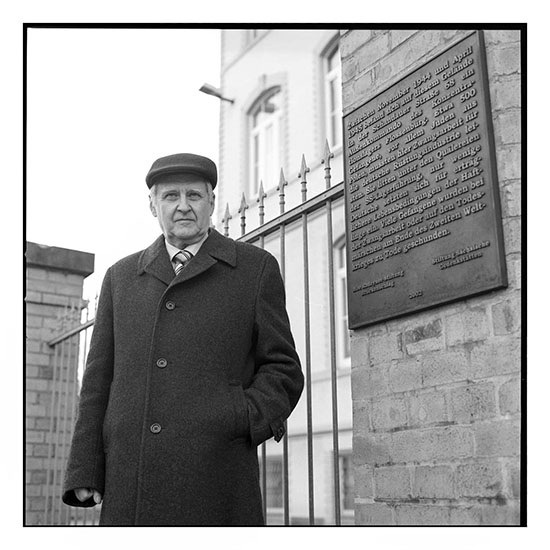
“In November 1944, as the eastern front began to move west, my mother, brother (age 3) and I ( age 11) were then taken by open cattle car to Dresden. The weather was frigid. With about 500 others we were forced to work in a cigarette factory at Schandauerstraße 68 which had been converted to an ammunition factory. I worked twelve hours everyday on a milling machine cutting metal that was made into ammunition encasements for the Wehrmarcht. If our daily quotas weren’t met we had to work longer hours but we made sure not to exceed the quotas as a sudell form of resistance. Any sabotage would have been dealt with harshly.
We were never allowed to leave the factory. On the afternoon of February 13th, just hours before Dresden was firebombed, an SS officer declared that my younger brother was to be executed the next day because he was too young to work and was “a useless eater.” That night Dresden was bombed. The workers and guards sat in the large cellar all night. The workers who were sick stayed above in the factory dormitories. The factory was hit by incendiary bombs and the upper floors of the building burned. Only those in the cellar survived. My nerves broke down during the bombings. Everytime I heard a plane I went diarrhea. For a while after I was extremely traumatized and stuttered while I spoke.
When we left the cellar in the morning, white ash was everywhere. There were a lot of dead bodies, buildings were damaged, trees were on fire and even the streets had melted. I was ordered to clean up the rubble that was blocking streets and railway tracks while adults had to carry corpses.
In April we were put on a forced death march south west because the SS were fearful of the advancing Red Army. We were given no food and many of us were emaciated. At one point we were attacked by an Allied plane. The SS officers, who were guarding us, ordered us to jump into a ditch on the side of the road. After the plane flew away my mother, brother and I stayed on the ground and didn’t move while the SS officers quickly forced the others to continue. In their rush to flee they must have thought we were dead. After they left I went to a farmer in Pilsen, who gave me food. The first ten years after the war we didn’t speak about it.
The first time I came back to Dresden was in 1955 to meet with the others who had been forced to work in the factory. During the time of the GDR, I wrote to East German officials about my experiences at the factory but they denied that such a factory existed. After reunification a plaque was placed outside the factory saying that a lot of people were forced to work there during the Second World War.”
-Michal Salomonovič, Dresden firebombing survivor
Mr. Salomonovič is photographed outside the factory at Schandauerstraße 68. His family was originally from Ostrava, Czech Republic and were deported by the Nazis from Prague when he was 8 years old to Lodz ghetto then to several concentration camps before being sent to Dresden to work as a forced laborer.On February 13th, 1945 the baroque city of Dresden, Germany was firebombed into cinder by the British Royal Air Force and the United States Army Air Force. The attack was divided into three bombing raids dropping over 4,500 tons of high explosives, including incendiary bombs, onto the city known as “Florence on the Elbe.”
This portrait is a part of my From Above project which featured portraits of atomic bomb and firebombing survivors from WWII. My limited edition book is available at https://www.photoeye.com/bookstore/citation.cfm?catalog=I1040&i=&i2=
Tags: Dresden, Dresden firebombings February 13 1945, From Above, Michal Salomonovič